| Previous Soldier's Profile | Soldier's Profile Home Page | 16th OVI Home Page | Next Soldier's Profile |
Eli Wheeler Botsford
Major, Field and Staff
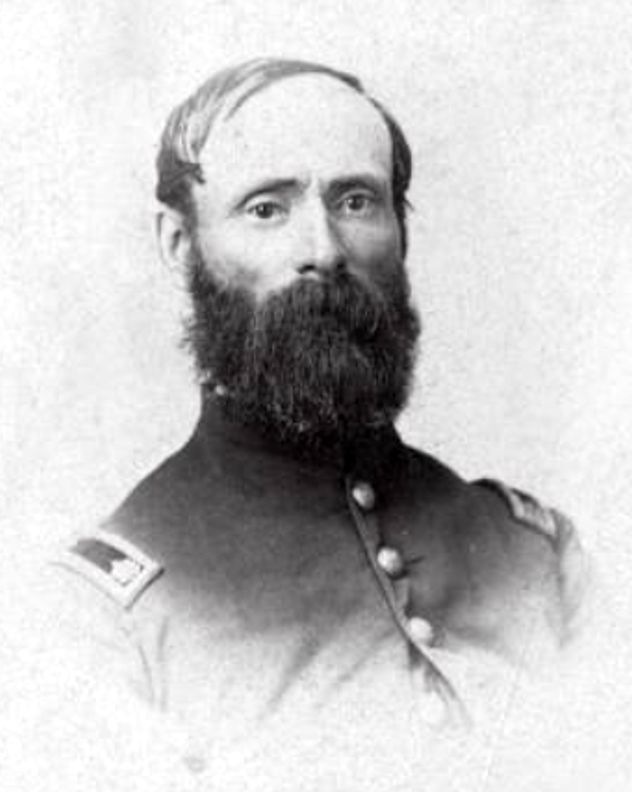
| Personal | |||||||||
|---|---|---|---|---|---|---|---|---|---|
| born: | 1821 | place: | Newtown, Connecticut | ||||||
| father: | David Bellamy Botsford | born: | 1792 | place: | died: | 1879 | place: | Newtown, Connecticut | |
| mother: | Harriet Wheeler | born: | 1794 | place: | died: | place: | Wooster, Ohio | ||
| pre-war occupation: | place: | post-war occupation: | cheese merchant dry goods merchant |
place: | |||||
| married: | October 14, 1869 | to: | Annie Wines | place: | Ft. Wayne, Indiana | ||||
| wife born: | place: | died: | place: | ||||||
| child: | Elizabeth | born: | September 18, 1870 | place: | died: | place: | |||
| child: | Edith | born: | 1873 | place: | died: | place: | |||
| child: | Susan | born: | 1879 | place: | died: | place: | |||
| died: | March 6, 1894 | place: | Wooster, Ohio | cause of death: | pneumonia |
| Military Career | |||||
|---|---|---|---|---|---|
| Mexican War: | 1847 (assumed) | Sergeant-Major | 2nd Ohio Infantry | place: | |
| discharged: | June 23, 1847 | mustered out with regiment | place: | New Orleans, Louisiana | |
| Civil War 3-year service: | September 19, 1861 | Captain | Company C, 16th OVI | place: | |
| acting: | December 29, 1862 | regimental commander | 16th OVI | ||
| promoted: | March 18, 1864 | Major | Field and Staff | ||
| discharged: | October 31, 1864 | mustered out with regiment | place: | ||
Additional Details
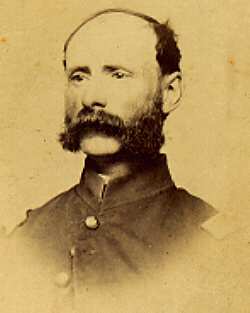 |
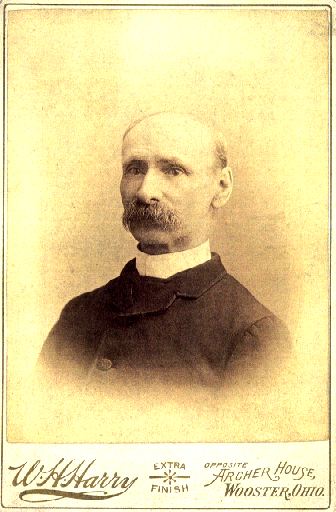 |
Maj. Botsford in uniform
|
Eli Botsford after the war
|
The following text contains excerpts from a document compiled by Frederick Wines Cowles, the son-in-law of Eli Botsford, and has been kindly provided by Eli's great-great grandson, John C. Fowler:
MILITARY SERVICE OF MAJOR ELI WHEELER BOTSFORD
in the
MEXICAN and CIVIL WARS
Compiled by Frederick Wines Cowles
Major Botsford came from a long line of military ancestors. Three brothers came over to America from Abbotsford, England, in the pre-Revolutionary era. They bore the name of their native town, but found it too long, so they dropped the Ab
, and the name has been handed down as Botsford
. Eli's father was David B. Botsford, who was born in 1792 and died in 1879. It is believed he lived and died in Newtown, Connecticut. His mother was Harriet Wheeler, born in 1794, date of death unknown. She was the daughter of Joseph Wheeler, a soldier of the Revolution, born in 1734, lived in Newtown, Connecticut, and died in 1818. His wife was Keziah Botsford, born in 1737, in Newtown, Connecticut, and died in 1821, and was married to Joseph Wheeler on March 15, 1755, in Newtown.
Eli W. Botsford was born in Newtown, Connecticut, in 1821, and died in 1893 in Wooster, Ohio, where he is buried. His maternal parents, the Wheelers, are also buried there. Eli served as Sergeant-Major, 2nd Ohio Infantry in the Mexican War. The regiment somehow reached Matamores, Texas, probably by boat from Cincinnati. President Polk issued a first call for three regiments from Ohio on May 20, 1846. George W. Morgan of Mount Vernon, Ohio, was the colonel. His old home remains today at 201 East Gambier Street, just one block west of the home at 305 now owned by Major Botsford's granddaughter. Eli was just 25 years of age at the time of his enlistment in the 2nd regiment. They left July 9, 1846, from Cincinnati for Mexico, and in three weeks reported to General Taylor, who ordered them to Camargo. This is a town on the Mexican side of the Rio Grande about thirty or forty miles from its mouth. The regiment then did escort duty between Camargo and Monterey, about 75 miles inland and southwest from Camargo. They fought in battles or skirmishes at Aqua Fria and Buena Vista and lost 6 killed in battle, 2 drowned, and 60 from disease. They were mustered out June 23, 1847, at New Orleans.
Various stories have been handed down in the family about Eli's age. One is that he was born in 1830 instead of 1821, and as a lad was too young to enlist, so he ran off and joined General Kearney's army and went with them when the Army went west where they conquered what is now New Mexico, establishing a provisional government in Santa Fe. However, his gravestone in Wooster, Ohio, gives the date of birth as 1821.
Because Eli was born in Newtown, Connecticut, he was reared under a stern set of Blue Laws. They observed Sunday in the old Puritan way. Children were curtailed in all their natural activities on that day. He used to tell about the way that he and his friends would retire to some roundabout hills near Newtown on Sunday evening and wait for the sun to go down. As soon as it disappeared, they would begin their coasting with a whoop-and-holler and let off steam from their Sunday restraint. However, the family moved to Cleveland, Ohio, and one sister married and moved to Topeka, Kansas. His brother Will remained in Cleveland. Eli, too, stayed in the Western Reserve. Rumor also has it that he attended Oberlin College sometime between the Mexican and Civil War. however, he must have visited frequently in Ft. Wayne, Indiana, because it was there on October 14, 1869 that he married Annie Wines, a member of a prominent Ft. Wayne family who had settled there as pioneers early in the century.
Three daughters were born to them in Wellington--Elizabeth in September 18, 1870, Edith in 1873, and Susan in 1879. Eli had a cheese business as Commission Merchant in Wellington, and later moved to Wooster, where he tried to operate a Dry Goods store. Neither of these ventures were successful financially. He lived on a Civil War pension in Wooster and was Treasurer and Secretary for the Masonic organization and a very active member. He was made Knight's Templar, and at the time of his death in 1893 held the state of Ohio record for the longest membership. While not successful in business, he was still active physically for at the age of 72 he went ice skating on the old Canal between Wooster and Apple Creek, and in so doing caught a bad cold which caused pneumonia and he died in Wooster a week later.
From December 20, 1862 to January 23, 1863, (the 16th Ohio Volunteers) took part in the Yazoo Campaign. They proceeded up the Yazoo several miles and prepared to assault Vicksburg on the Chickasaw Bluff side. The assault took place on December 29th (1862) and they lost heavily with many officers and men killed, wounded and captured.
As a preliminary to Grant's campaign against Vicksburg, they participated in the battle of Champion Hills, Thompson Hill, and Black River Bridge. They were actively engaged in the assault on Vicksburg, Mississippi, from May 18 to July 4, which was captured on that date after terrific fighting. The actual assault on Vicksburg lasted from May 19 to 22. In this engagement all the commanding officers were killed in Eli's regiment, and he had time only to take the red sash from the body of his superior officer, tie it around his belt, and take command of the unit. In this way he became Major.
[As often happens, memories fade and stories get mixed up through time. This last sentence actually refers to the December 29, 1862 Battle of Chickasaw Bayou, mentioned in the previous paragraph. However, none of the regiment's commanders were killed at that battle, although the commander, Lt. Col. Philip Kershner, was taken prisoner and did not return to the regiment until October, 1863. Botsford did assume command of the regiment on that date and held the position until the return of Maj. Milton Mills, also captured at Chickasaw Bayou, who assumed command on June 3, 1863. The story about removing the red sash from the body of his superior officer is highly unlikely as only one 16th Ohio officer, Captain George Harn, was actually killed at the battle.]
On March 18, 1864, he was definitely and officially promoted to Major and assigned to Field and Staff. This story is verified by his daughter, Mrs. J. Ray Barber, who heard him tell it many times. There is a fine monument to Major Eli Botsford [The monument is actually dedicated to the entire 16th Ohio Infantry regiment and includes the names of Capt. Eli Botsford and Maj. Milton Mills, the regiment's commanders at the time of the assaults and siege of Vicksburg.] erected in his memory at Vicksburg, and it can be located through the cemetery office.
After Vicksburg, the regiment was ordered to New Orleans August 13th and saw duty there until September 6. They remained at Brashear City until October and then took part in the Western Louisiana Campaign from October 3 to November. Here they joined General Washburn's expedition against Texas. They moved on DeCrow's Point Matagorda Bay, Texas, November 18 to 28, and saw duty there until January 1864, and at Matagorda Island until April. They then moved to New Orleans on April 18, where they joined General Washburn. From New Orleans they were ordered to Alexandria on the Red River to reinforce the river banks and help in the construction of a dam to facilitate the escape of the iron-clad fleet. Retreat to Morganze Bend on the Mississippi River followed from May 13th to 20th. They stayed there until October with a short expedition to the Atchafalaya. They then received their orders to report to Columbus, Ohio, to be mustered out October 31, 1864, the expiration of their term of enlistment, three years.
The regiment saw severe fighting and suffered greatly from wounds and disease. A total of 286 men were lost during service including 2 officers and 217 enlisted men dead from disease. The command was noted for its fine, manly, military bearing.
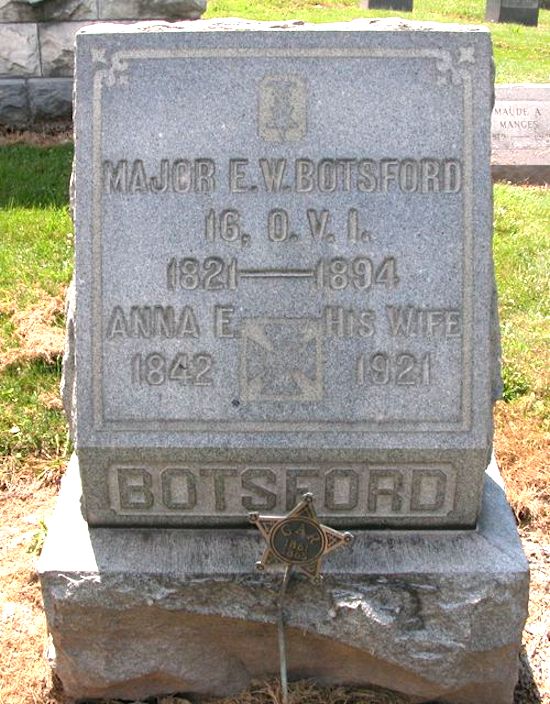 |
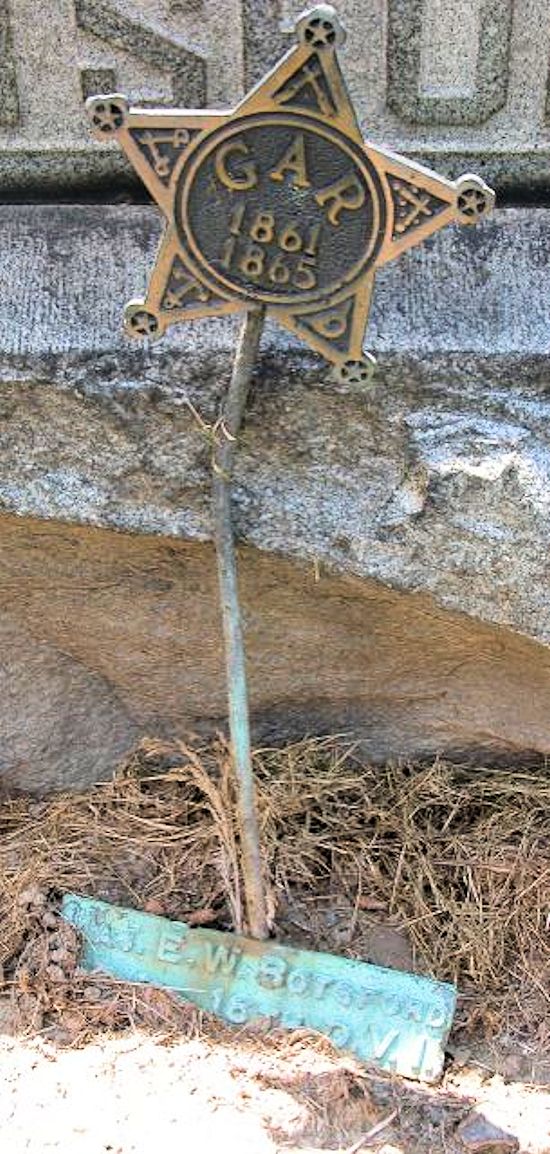 |
Maj. Botsford's gravesite in Wooster Cemetery, Wooster, Ohio |
Close-up of Maj. Botsford's GAR marker at his gravesite |
| Previous Soldier's Profile | Soldier's Profile Home Page | 16th OVI Home Page | Next Soldier's Profile |